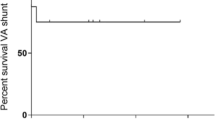Abstract
Long-term shunt dependency rates in children treated for IIH with CSF diversion have not been established. We therefore present our experience with 4 children shunted for Idiopathic Intracranial Hypertension (IIH) during the years 1988–2000 with very long-time follow-up. Two out of these patients have experienced late or very late episodes of severe shunt failure during the second or third decade after initial shunt treatment. They were all boys and may not be representative for IIH patients as a whole. Two of them appear, however, to be permanently shunt dependent, indicating that long-term shunt dependency in children treated for IIH with CSF diversion may be more common than previously expected.
Similar content being viewed by others
Abbreviations
- CSF:
-
Cerebrospinal fluid
- LP:
-
Lumbar puncture
- IIH:
-
Idiopathic intracranial hypertension
References
Dandy WE (1937) Intracranial pressure without brain tumor. Ann Surg 106(4):492–513
Foley J (1955) Benign forms of intracranial hypertension; toxic and otitic hydrocephalus. Brain 78(1):1–41
Johnston I, Besser M, Morgan MK (1988) Cerebrospinal fluid diversion in the treatment of benign intracranial hypertension. J Neurosurg 69:195–202
Karsy M, Haussam A-A-S, Bowers CA, Schmidt RH (2018) Treatment of idiopathic intracranial hypertension via stereotactic placement of biventriculoperitoneal shunts. J Neurosurg Jan 1:1–9
Kidron D, Pomeranz S (1989) Malignant pseudotumor cerebri. Report of two cases. J Neurosurg 71:443–445
Niotakis G, Grigoratos D, Chandler C, Morrison D, Lim M (2013) CSF diversion in refractory idiopatic intracranial hypertension: single-center experience and review of efficacy. Childs Nerv Syst 29:263–269
Paulsen AH, Due-Tønnessen BJ, Lundar T, Lindegaard K-F (2017) Persistent shunt dependency and very late shunt failure in a 3-year-old boy with idiopathic intracranial hypertension (IIH). Childs Nerv Syst 33:213–215
Paulsen AH, Lundar T, Lindegaard K-F (2015) Pediatric hydrocephalus: 40-year outcomes in 128 hydrocephalic patients treated with shunts during childhood. Assessment of surgical outcome, work participation, and health-related quality of life. J Neurosurg Pediatr 16:633–641
Paulsen AH, Lundar T, Lindeggard K-F (2010) Twenty-year outcome in young adults with childhood hydrocephalus: assessment of surgical outcome, work participation, and health-related quality of life. J Neurosurg Pediatrics 6:527–535
Roth J, Constantini S, Kessler A (2015) Over-drainage and persistent shunt-dependency in patients with idiopathic intracranial hypertension treated with shunts and bariatric surgery. Surg Neurol Int 6:S655–S660
Author information
Authors and Affiliations
Corresponding author
Ethics declarations
Conflict of interest
The authors declare that they have no conflict of interest.
Ethical approval
All procedures performed in studies involving human participants were in accordance with the ethical standard of the institutional and/or national research committee (REK) and with the 1964 Helsinki declaration and its later amendments or comparable ethical standards. For this type of study, formal consent is not required. Informed consent was obtained from all individual participants included in the study.
Additional information
Comments
The authors report on a series of five patients who underwent CSF diversion for idiopathic intracranial hypertension (IIH) as children between 1984and 2000. All were boys, and all were under five years of age at shunt implantation. Three of them required multiple delayed shunt revisions,suggesting that they were permanently shunt dependent. One patient had his shunt removed for overdrainage symptoms, under intracranialpressure monitoring. Another has not required revisions for a long time, and has been assumed to be shunt independent. The authors conclude thatshunt dependency after CSF diversion for IIH is commoner than previously thought.This is an interesting study and is particularly valuable because the follow-up, ranging from 19 to 35 years, is so long. It makes a valuable contribution to the literature on IIH presenting in childhood.
Kristian Aquilina
London, UK
Publisher’s note
Springer Nature remains neutral with regard to jurisdictional claims in published maps and institutional affiliations.
This article is part of the Topical Collection on Pediatric Neurosurgery
Rights and permissions
About this article
Cite this article
Lundar, T., Due-Tønnessen, B.J. Persistent shunt dependency in children treated with CSF diversion for idiopathic intracranial hypertension (IIH). Acta Neurochir 162, 39–42 (2020). https://doi.org/10.1007/s00701-019-04142-6
Received:
Accepted:
Published:
Issue Date:
DOI: https://doi.org/10.1007/s00701-019-04142-6




